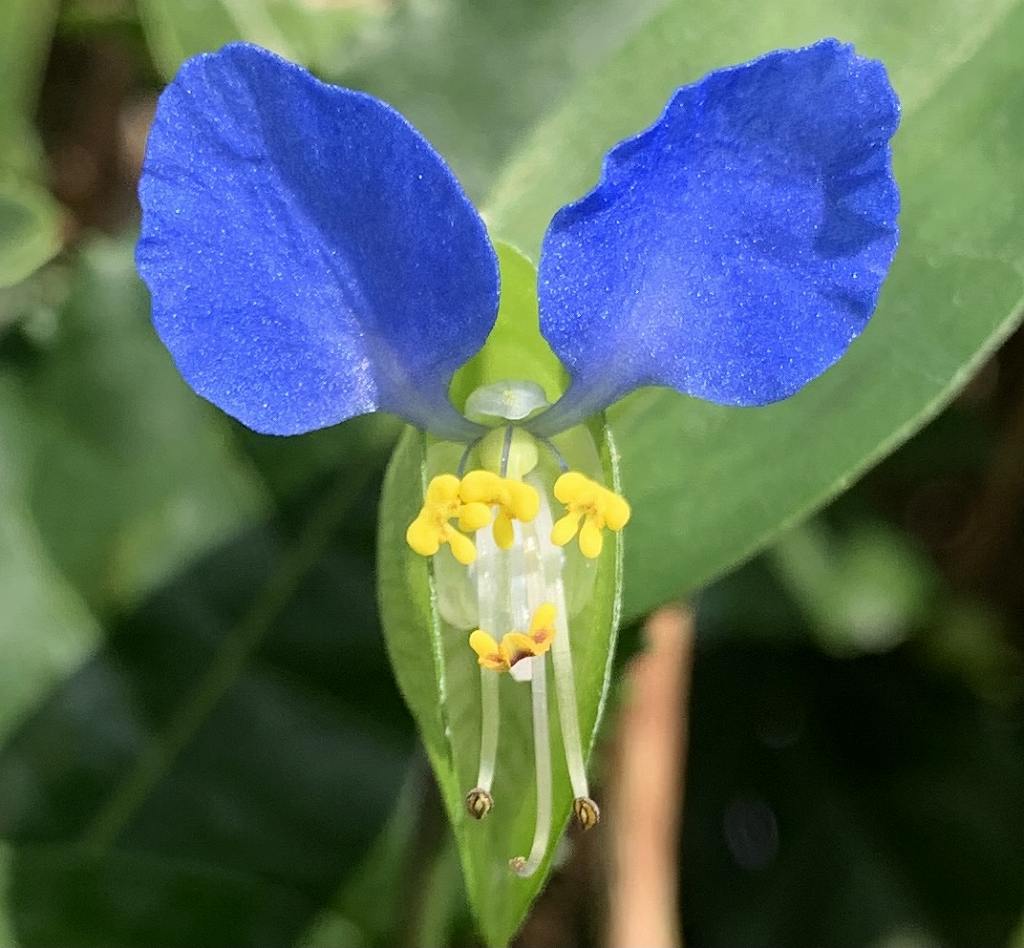ツユクサは朝咲いた花が昼に萎みます。現れては消える朝露のよう。日本では儚さを象徴する花として古くから親しまれてきました。
The flowers of asiatic dayflower that bloom in the morning wither in the daytime. It’s like morning dew that appears and disappears. In Japan, it has been popular since ancient times as a flower that symbolizes fragility.
【仮名】ツユクサ, オウセキ
【和名】露草, 鴨跖
【英名】Asiatic Dayflower
【学名】Commelina communis
【誕生】07/ 06, 07/ 28
【開花】06, 07, 08, 09月
【花色】Blue



ツユクサ
ツユクサの分布
ツユクサはツユクサ科ツユクサ属の一年草です。原産地は日本を含む東アジア。ツユクサ属は世界に180種ほどで、日本に5種あります。畑の隅や道端で自生。茎は直立せず地面を這います。
ツユクサの花
ツユクサの花は大きさが2cmくらい。花弁は上に大きく目立つ青の2枚と、下に小さく目立たない白の1枚です。雌しべは1本、雄しべは6本。そのうち受粉の役に立つ雄しべは2本です。
ツユクサの名前
ツユクサは朝咲いた花が昼に萎みます。現れては消える朝露のようなので露草。英名も1日限りの花という意味です。万葉集では儚さを象徴する花。日本人に古くから親しまれてきました。
ツユクサの別名
ツユクサの別名は鴨跖草。正面から見た花の姿が鴨の堅い足の裏に似ているからです。万葉集には鴨頭草という表記も。そのほか、花の形から蛍草や帽子花、花の色から青花と呼ばれます。
ツユクサの古名
ツユクサの古名は「つきくさ」。これは花弁の青い色が衣類などに着く「着き草」だから。さらに和歌では「月草」の表記も。これらの読みが転じてツユクサになったともいわれています。
ツユクサの色素
ツユクサの花の青い色はコンメリニンというアントシアニン系化合物です。これは衣類に着いても落ちやすい色素。そこで、花の大きな改良種が染め物の下絵を描くために用いられました。
ツユクサの食用
ツユクサの食味はクセやアクがほとんどありません。柔らかい葉や茎はどんな調理法でもOK。一方、全草を採って乾燥させた生薬が鴨跖草と呼ばれ、下痢止め、解熱などに用いられます。
Asiatic Dayflower
Asiatic dayflower is an annual plant belonging to the genus Commelina communis in the family Commelina communis. The place of origin is East Asia including Japan. There are about 180 species of Commelina communis in the world, and there are 5 species in Japan. It grows naturally in the corners of fields and on the roadside. The stem does not stand upright and crawls on the ground.
The flower of asiatic dayflower is about 2 cm in size. The petals are two large blue ones on the top and one small and inconspicuous white one on the bottom. One pistil and six stamens. Two of them are useful for pollination.
The flowers of asiatic dayflower that bloom in the morning wither in the daytime. It looks like morning dew that appears and disappears, so it is a dayflower. The English name also means a one-day flower. A flower that symbolizes fragility in the Manyoshu. It has been popular with Japanese people for a long time.
Another name for asiatic dayflower is Commelina communis. This is because the appearance of the flower seen from the front resembles the hard sole of a duck. There is also a notation called duck head grass in the Manyoshu. In addition, it is called fireflies or hat flowers because of the shape of the flowers, and blue flowers because of the color of the flowers.
The old name of asiatic dayflower is “Tsukikusa”. This is because the blue color of the petals is the “grass” that reaches clothing. Furthermore, in Japanese poems, the notation “Tsukikusa” is also used. It is said that these readings turned into Commelina communis.
The blue color of the flower of asiatic dayflower is an anthocyanin compound called commelinin. This is a pigment that is easy to remove even when it gets on clothes. There, a large improved variety of flowers was used to draw a rough sketch of the dye.
The taste of asiatic dayflower has almost no habit or lye. Soft leaves and stems can be cooked in any way. On the other hand, the crude drug obtained by collecting and drying the whole plant is called Asiatic dayflower, which is used to prevent diarrhea and reduce fever.


